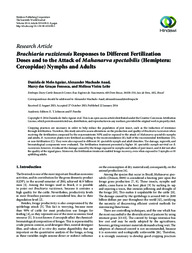Brachiaria ruziziensis Responses to Different Fertilization Doses and to the Attack of Mahanarva spectabilis (Hemiptera: Cercopidae) Nymphs and Adults.
Brachiaria ruziziensis Responses to Different Fertilization Doses and to the Attack of Mahanarva spectabilis (Hemiptera: Cercopidae) Nymphs and Adults.
Autoria: AGUIAR, D. DE M.; AUAD, A. M.; FONSECA, M. DAS G.; LEITE, M. V.
Resumo: Cropping practices are necessary in order to help reduce the population of pest insect, such as the induction of resistance through fertilization. Therefore, this study aimed to assess alterations on the production and quality of Brachiaria ruziziensis when receiving the fertilization composed by the macronutrients NPK and/or exposed to the attack of Mahanarva spectabilis nymphs and adults. B. ruziziensis plants were fertilized according to the recommendation (R), half of the recommended fertilization (H), or non-fertilization (C). They were also exposed to different M. spectabilis nymph and adult densities. The damage, regrowth, and bromatological components were evaluated. The fertilization treatment promoted a higher M. spectabilis nymph survival on B. ruziziensis; however, it reduced the damage caused by the forage exposed to nymphs and adults of pest insect, and it did not alter the quality of the signal grass. Moreover, the fertilization treatment enabled forage recovery, even when exposed to 5 nymphs or 10 spittlebug adults.
Ano de publicação: 2014
Tipo de publicação: Artigo de periódico
Unidade: Embrapa Gado de Leite
Palavras-chave: Crop fertilization, Pest insect
Observações
1 - Por padrão são exibidas publicações dos últimos 20 anos. Para encontrar publicações mais antigas, configure o filtro ano de publicação, colocando o ano a partir do qual você deseja encontrar publicações. O filtro está na coluna da esquerda na busca acima.
2 - Para ler algumas publicações da Embrapa (apenas as que estão em formato ePub), é necessário ter, no celular ou computador, um desses softwares gratuitos. Sistemas Android: Google Play Livros; IOS: iBooks; Windows e Linux: software Calibre.
Acesse outras publicações
Acesse a Base de Dados da Pesquisa Agropecuária (BDPA) para consultar o acervo completo das bibliotecas da Embrapa.

